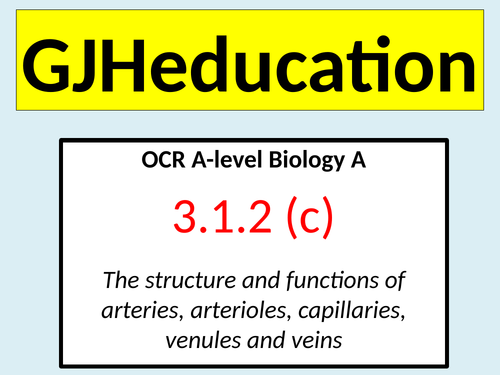



This fully-resourced lesson explores how the structure of arteries, arterioles, capillaries, venules and veins relate to their functions. The engaging and detailed PowerPoint and accompanying resources have been designed to cover point 3.1.2 © of the OCR A-level Biology A specification.
This lesson has been written to build on any prior knowledge from GCSE or earlier in this topic to enable students to fully understand why a particular type of blood vessel has particular features. Students will be able to make the connection between the narrow lumen and elastic tissue in the walls of arteries and the need to maintain the high pressure of the blood. A quick version of the GUESS WHO game is used to introduce smooth muscle and collagen in the tunica media and externa and again the reason for their presence is explored and explained. Moving forwards, it is quite likely that some students will not be aware of the transition vessels that are the arterioles. This section begins with an understanding of the need for these vessels because the structural and functional differences between arteries and capillaries is too significant. The action of the smooth muscle in the walls of these vessels is discussed and students will be challenged to describe a number of situations that would require blood to be redistributed. The middle part of the lesson looks at the role of the capillaries in exchange and links are made to diffusion to ensure that students can explain how the red blood cells pressing against the endothelium results in a short diffusion distance. The remainder of the lesson considers the structure of the veins and students are challenged to explain how the differences to those observed in arteries is due to the lower blood pressure found in these vessels.
It is estimated that it will take at least 2 hours of allocated A-level Biology teaching time to cover the detail included in this lesson
Get this resource as part of a bundle and save up to 44%
A bundle is a package of resources grouped together to teach a particular topic, or a series of lessons, in one place.
Module 3: Exchange and transport (OCR A-level Biology A)
This bundle contains 18 detailed and engaging lessons which cover the following specification points in module 3 (Exchange and transport) of the OCR A-level Biology A specification: 3.1.1: Exchange surfaces * The need for specialised exchange surfaces * The features of an efficient exchange surface * The structures and functions of the components of the mammalian gaseous exchange system * The mechanism of ventilation in mammals * The mechanisms of ventilation and gas exchange in bony fish and insects 3.1.2: Transport in animals * The double, closed circulatory system in mammals * The structure and functions of arteries, arterioles, capillaries, venules and veins * The formation of tissue fluid from plasma * The external and internal structure of the heart * The cardiac cycle * How heart action is initiated and coordinated * The use and interpretation of ECG traces * The role of haemoglobin in transporting oxygen and carbon dioxide * The oxygen dissociation curve for foetal and adult haemoglobin 3.1.3: Transport in plants * The structure and function of the vascular systems in the roots, stems and leaves * The transport of water into the plant, through the plant and to the air surrounding the leaves * The mechanism of translocation As well as the detailed A-level Biology content of the PowerPoint slides, the resources contain a wide range of tasks including guided discussion points, exam-style questions and quiz competitions which will engage and motivate the students
Module 3.1.2: Transport in animals (OCR A-level Biology)
Each of the 9 lessons in this bundle are fully-resourced and have been designed to cover the content as detailed in module 3.1.2 (Transport in animals) of the OCR A-Level Biology A specification. The specification points that are covered within these lessons include: * A double, closed circulatory system * The structure and function of arteries, arterioles, capillaries, venules and veins * The formation of tissue fluid from plasma * The internal and external structure of the mammalian heart * The cardiac cycle * How heart action is initiated and coordinated * The use and interpretation of ECGs * The role of haemoglobin in transporting oxygen and carbon dioxide * The dissociation curve for foetal and adult haemoglobin * The Bohr effect The lessons have been written to include a wide range of activities and numerous understanding and prior knowledge checks so students can assess their progress against the current topic as well as be challenged to make links to other topics within this topic and earlier topics If you would like to see the quality of the lessons, download the formation of tissue fluid. heart action and ECGs lessons as these are free
Something went wrong, please try again later.
This resource hasn't been reviewed yet
To ensure quality for our reviews, only customers who have purchased this resource can review it
Report this resourceto let us know if it violates our terms and conditions.
Our customer service team will review your report and will be in touch.